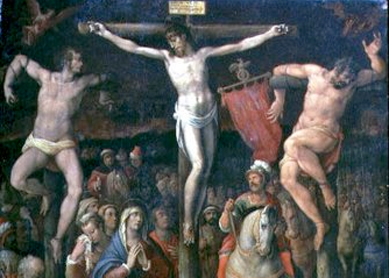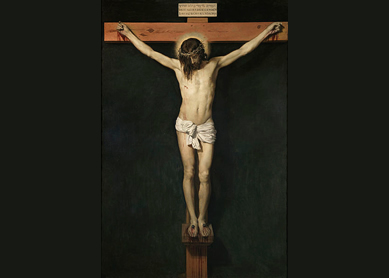The Crucifixion is one of the most easily identifiable scenes in the history of western art. The earliest representations date from the 4th century C.E. Although all four Gospel writers tell the story of Jesus’ crucifixion, most artists have preferred to focus on the details found in John 19:25-27 and Luke 23:33-43. Throughout the ages, artists used the crucifixion in art not just as faithful illustrations of particular gospel scene but also as ways of conveying theological lessons. These lessons differed in complexity and nature. For example, in the sixteenth century the force of the Protestant Reformation and the subsequent Catholic Counter-Reformation led to the convening of the Council of Trent. The Council of Trent’s 25th (and final) session on December 4, 1563 required artists to paint narratives that were taken directly from scripture or church teachings. The works had to be decorous and serve a teaching function.
One particular painting from this era demonstrates an exceptional interpretation of Luke’s crucifixion scene: the Crucifixion by Jan van der Straet (1523-1605), also known as Giovanni Stradano. Stradano was a Flemish artist who moved to Florence to study Italian art and culture, and his painting of the crucifixion proves to be a reliable guide through the theological subtleties associated with depicting Jesus’ death during the period of Italian art post-Trent. The renovation of Florence’s SS. Annunziata, which included Stradano’s painting Crucifixion, was part of a citywide project to modernize chapels and reemphasize the teaching of biblical stories through art.
Stradano painted in a bold new style known as Mannerism. He broke from the conventional depictions of the crucifixion to capture the moment in Luke’s crucifixion narrative, when Jesus says to the repentant thief, “Truly I tell you, today you will be with me in Paradise” (Luke 23:43). If the Crucifixion story was intended to teach beyond the basic premise that Christ must die in order to be resurrected, then the symbolism of the penitent thief offers a more personal understanding of the acceptance and forgiveness of Christ to those who seek to be with him in heaven.
Many symbolic elements pervade Stradano’s painting: Christ is the New Adam, Mary is the New Eve, the Cross is the tree of life, and a dog in chains represents the defeated Satan. Perhaps the most striking visual element is in the bottom middle of the painting. The location of the crucifixion is known in Luke as the “Skull” place. Instead of only a skull appearing at the foot of the cross as you conventionally find in medieval crucifixion scenes, Stradano draped an entire skeleton across the area immediately in front of the cross. This represents a long-standing tradition from as early as the fourth century that asserts that the “Skull” place was the final resting place of the bones of Adam. Because of his sin, the first man, Adam, gives authority over humankind to Satan (represented by the dog), who binds people in suffering and sin. Through his death, Christ defeats Satan, transforms Hades into paradise, and redeems humanity (represented by Adam). Stradano captures each of these themes using characteristics of the Mannerist style of painting: elongated proportions, contorted body positions, and use of vibrant yellow and orange colors in the fabrics to guide the eye to the essential figures.
As decreed by the Council of Trent, the Renaissance believer would have meditated on the suffering and death of Christ through Stradano’s sacred painting. In it, he or she would have seen a defeated Satan, a rescued criminal, and a redeemed humanity thanks to the salvific, forgiving and accepting powers of “Christ the King.”


